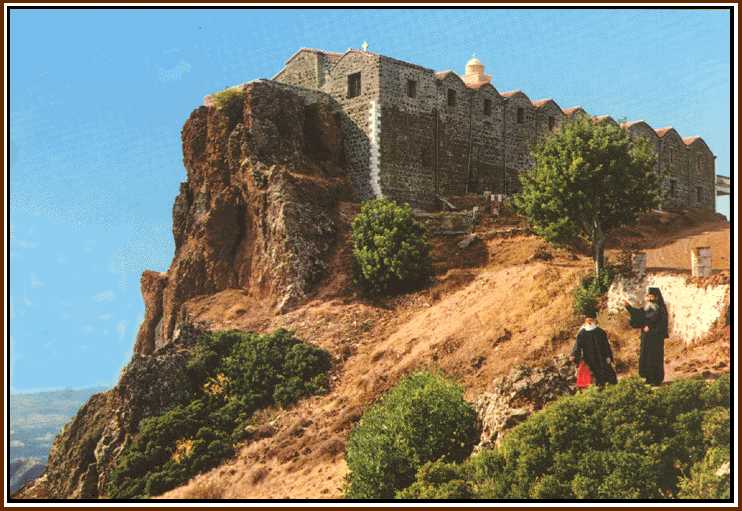
View of the monastery
|
The monastery Stavrovouni was constructed on the peak of the mountain of the same name in the district of Larnaca . In earlier times it had been known under the name of Olympus , nowadays , the highest point of Troodos Mountains further to the west bears that name . Stavrovouni , as the name already says , is dedicated to the Holy Cross ; it can be derived from two words 'stavros '(cross) and 'vouno' (mountain) . According to religious tradition , the monastery was founded by St. Helena , the mother of the Byzantine Emperor Constantine I , the Great . According to the 15th. century Cypriot chronicler Leontios Machairas , Helena had discovered the three crosses on which Jesus and the two thieves had been crucified on her pilgrimage to the Holy Land . She had them excavated and wanted to bring them to Constantinople . But she is said to have left one of these crosses in Cyprus during an involuntary visit caused by shipwreck , and to have presented it to a monastery . Thus the legend . Stavrovouni is the earliest documented monastery on the island . The oldest written reference dates from the Byzantine period . It proves that Stavrovouni had been an important religious centre since the 4th. century . The relevant information is to be found in the memoirs of a Russian traveller , Abbot Daniel , who stayed on Cyprus in 1106 . He recorded that the Holy Cross was located on Mount Olympus with objective of 'warding off evil spirits and curing any illness ' , and he noted : 'This cross is like a meteorite , it is not supported in the ground , because the Holy Ghost holds it in the empty space . I , unworthy man , knelt down before this holy , mysterious object and have seen with my own , sinful eyes the inherent holy grace present in this place . ' After its foundation , Stavrovouni was occupied by Orthodox monks living according to the rule of St. Basil . We obtain further historical information from Western visitors to Cyprus in the 13th. century . Willibrandi de Oldenburg , for example , visited Stavrovouni in 1211 and wrote : 'The cross of the Good Thief is on the highest mountain in Cyprus' - which was wrong , as Stavrovouni is not as high as the Troodos peak . Ludolph von Suchen noted in 1305 : 'The mountain is like the Mount Tabor on which the Benedictine monks live . From its peak one can see the Lebanon .' That is true , but the weather must be very clear in order to be able to check this . In its long history , Stavrovouni went through times of great poverty and hardship caused by the most varied invasions by foreigners on the island . Nowadays , the Holy Cross is no longer there and nobody knows what has happened to it . In 1598 , the Bohemian nobleman Krystof Harant noted :'Nobody knows what the Turks have done with the Holy Cross .' The walls , the church , the iconostasis and monks' cells in Stavrovouni were almost completely destroyed during a great fire in 1888 . The only relic which has been preserved down to the present is a silver cross in which a minute piece of the holy cross is inserted , the only major reliquary which is still kept in Stavrovouni . Recently , the monastery underwent a complete renovation . Its small church was restored again with frescoes and icons by well-known painter , Fr. Kallinikos , a monk from Stavrovouni . The legend of the foundation is recorded in these pictures , St. Helena in a brilliant red garment and the Finding of the True Cross in Jerusalem . By the way , the emperor's mother recognised that she did have the right cross by the miraculous healing of a woman . Colourful , but also not without the skull painted beneath Christ's Cross for centuries is the Deposition . The majority of the frescoes in the church refer to the Cross and the life of St. Helena . In this manner , Stavrovouni is continuing the deeply-rooted Byzantine painting tradition . The present monks in Stavrovouni live a very strict form of monastic life , similar to that of the monks on Mount Athos . The rule of their first abbot , Dyonisios , forms the basis of this . Perhaps that is why it is still forbidden even today for women to visit Stavrovouni . This is not the case in any of the other monasteries and churches in Cyprus . |